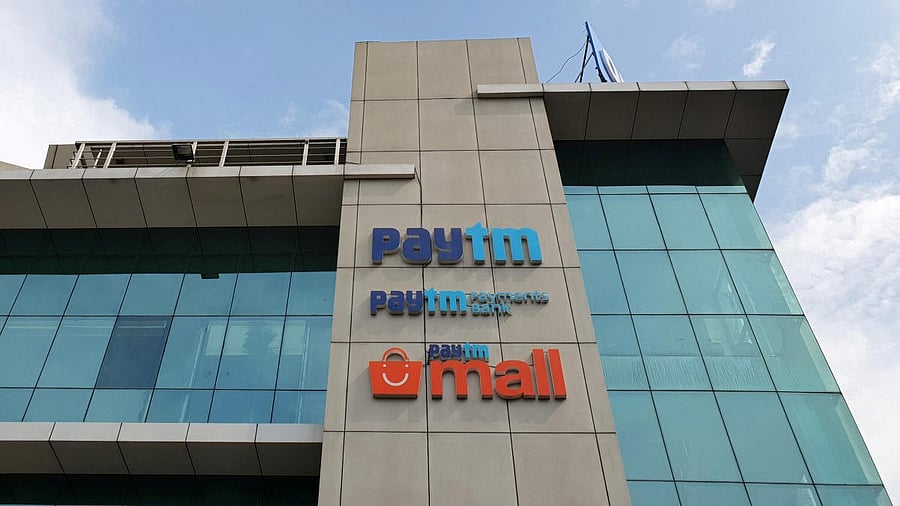
Paytm Payments Bank logo seen here
Credit: Reuters File Photo
In 2014, payments banks were conceptualised to provide financial inclusion services of small savings accounts and payments/remittance services to migrant labour workforce, low-income households, and small businesses.
Payments bank licences were promised to new-age operators, including non-bank pre-paid payment instrument (PPI) issuers, corporate business correspondents (BCs), and mobile telephone companies.
Payments banks were constrained to accept demand deposits with a maximum balance of Rs 1,00,000 per individual customer (later raised to Rs 2,00,000). They could issue ATM/debit cards, but not credit cards, and were debarred from lending activities. There were other restrictions as well.
Payments banks were undoubtedly a weakling in design.
Interest waned
Initially, there was good interest. On February 4, 2015, the Reserve Bank of India (RBI) announced that 41 entities applied for a licence including fintech companies, BCs, and technology corporates.
On August 19, 2015, the RBI granted in principle licences, valid for 18 months, to 11 applicants to set up payments banks: Aditya Birla Nuvo Limited, Airtel M Commerce Services Limited, Cholamandalam Distribution Services Limited, Department of Posts, Fino PayTech Limited, National Securities Depository Limited, Reliance Industries Limited, Dilip Shantilal Shanghvi, Vijay Shekhar Sharma, Tech Mahindra Limited, and Vodafone m-Pesa Limited.
Some of them did not pursue it. Six licences were granted finally: Airtel Payments Bank, India Post Payments Bank, Fino Payments Bank, NSDL Payments Bank, Jio Payments Bank, and Paytm Payments Bank.
A sobering rollout
The RBI report on Trend and Progress of Banking in India 2023-2024 informs that the payments banks earned a total income of Rs 7,102 crore (0.3% of total scheduled banks’ income) incurring an aggregate net loss of Rs 1 crore.
While the payments banks had earned a profit of Rs 120 crore in 2022-2023, in all the previous three years, they had reported net losses of Rs 335 crore, Rs 300 crore, and Rs 91 crore respectively.
The performance data relates to only four payments banks when cross checked from the detailed banking statistical reports published by the RBI. There is no performance data for Jio Payments Bank and NSDL Payments Bank.
Two ‘non-operating’ payments banks
The Jio Payments Bank commenced operations on April 3, 2018. Its financial and performance data, available from its published annual report, are only up to 2022-2023.
For 2022-2023, it reported a total income of Rs 13.86 crore and a net loss of Rs 44.47 crore, with its accumulated losses rising to Rs 184.93 crore. With its operational roll-out seemingly getting delayed, the SBI recently sold its 17.8% share in Jio Payments Bank to Jio Financial Services Ltd. making the former a 100% subsidiary of the latter.
The NSDL Payments Bank commenced operations on October 29, 2018. It reported a total income of Rs 6.37 crore and a net loss of Rs 13.87 crore for 2019-2020. For 2023-2024, the bank has reported a total income of Rs 11.75 crore and a net profit of Rs 1.71 crore. Its total accumulated losses stand at Rs 38.08 crore at the end of 2023-2024.
These two payments banks are in existence more in form and seem operationally moribund.
Regulatory action
The Airtel Payments Bank (licenced in November 2016) has been on the wrong side of RBI regulatory actions. In March 2018, the central bank imposed a penalty of Rs 5 crore on it for opening customer accounts without clear/specific consent. The RBI reported receiving the second-highest number of complaints against the bank in 2022-2023, among payments banks. The Airtel Payments Bank has accumulated losses of a whopping Rs 1,909 crore.
The Paytm Payments Bank licence has faced more existential regulatory action. On March 11, the RBI debarred it from onboarding new customers. On January 31, 2024, the RBI effectively suspended its licence citing persistent non-compliances and material supervisory concerns. The bank was stopped from taking further deposits and undertaking many banking services like fund transfers. In addition, nodal accounts of One97 Communications Ltd and Paytm Payments Services Ltd were also directed to be terminated.
The Paytm Payments Bank is defacto dead, and the Airtel Payments Bank is effectively Airtel’s in-house bank.
India Post Payments Bank kept afloat
The India Post Payments Bank (IPPB), owned by the Government of India, is surprisingly a physical bank with 649 banking outlets managed by the IPPB staff besides drawing on the network of post offices.
The IPPB reported unusual profits of Rs 20.16 crore and Rs 34.24 crore for 2022-2023 and 2023-2024 respectively. Earlier, it was incurring heavy losses — Rs 320.54 crore in 2020-2021 and Rs 159.62 crore in 2021-2022. It has accumulated losses of Rs 927.80 crore.
Besides liberal infusion of equity, the government has granted many other accommodations which make the IPPB earn high-interest income on its investments.
Birds of passage
The Fino Payments Bank will finally get converted into a small payments bank. The IPPB which complements India Post small saving bank accounts might not be needed in the future.
The UPI system has made all savings bank accounts full-service payments banks. So are the millions of PPI pay wallets operated by standalone operators and digital NBFCs.
India does not need separate payments banks. No tears will be shed if the existing six payments banks get closed, converted into small finance banks, or merged with other banks.
The payments banks will prove to be a short life experiment.
(Subhash Chandra Garg is former Finance & Economic Affairs Secretary, and author of ‘The Ten Trillion Dream Dented’, Commentary on Budget 2024-25 and ‘We Also Make Policy’.)
Disclaimer: The views expressed above are the author's own. They do not necessarily reflect the views of DH.